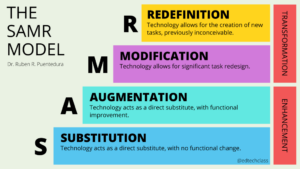Tech It Up a Notch: The SAMR Model for Transformative Teaching and Learning
If there is one thing I know about education, it is that we love an acronym. As we continuously wade our way through the alphabet soup of education terminology, we occasionally come across an acronym that is not only intriguing but also requires a deep dive to fully understand and appreciate the actual content.
May I introduce: the SAMR Model
The SAMR model was founded by Dr. Reuben Puentedura in 2009 (Tunjera & Chigona, 2020). The model’s design is a tool through which teachers can monitor the use of technology within their classroom (Hamilton et al., 2016). The letters in SAMR stand for Substitution, Augmentation, Modification, and Redefinition. The letters represent the levels of technology integration. The levels are also helpful in implementing various classroom activities (Hilton, 2016). (And thank you PressBooks!)
When I was first introduced to the SAMR Model, I was working at another education technology company, surrounded by edtech enthusiasts who were excited to see what technology could really do in the classroom. As an educator in the 21st century, technology is not only something that we utilize in the classroom but something we can maximize to the benefit of our students. There are hurdles, no doubt. I have worked with several colleagues and other education professionals who are self-admittedly “not good with technology”… and that’s okay. The beauty of the SAMR Model is that it essentially acknowledges where you are in the process of developing comfort with technology sans judgment. At the same time, it gives you a clear path to what is possible.
The SAMR Model is the model of possibility
If you have been following along with my personal journey alongside AI (See: “The ABCs of ChatGPT” and “Who’s Afraid of ChatGPT?”), you have seen how ChatGPT has impacted my own writing process as well as the stories of others who are leveraging its possibilities.
Admittedly, I knew what SAMR was but really didn’t fully understand the nuances of it. Substitution and Augmentation made sense to me and I felt like if I was back in the classroom, I would be able to achieve these two levels of the model. However, when it got to Modification and Redefinition, I felt like I was in a little over my head.
When I feel like this, my natural inclination is to ask questions. I want to learn and I want to understand examples that go along with those definitions so I can really see what it would look like in reality. When things get too theoretical, I shut down. When things seem too unachievable, I put them on the back burner. That was my attitude about Modification and Redefinition: ain’t nobody got time for that!
In my question quest, I asked my good friend ChatGPT to explain it to me as if I was a five-year-old and baby-step my way into understanding. And for the sake of full transparency, here is what ChatGPT had to offer:
SAMR is a model that helps teachers use technology in their lessons. Let me break it down for you like you’re 5 years old.
- Substitution: This is when we use technology to do the same thing we could do without it, just with a different tool. It’s like using a toy car to play instead of a real car. For example, if you use a tablet to read an e-book instead of a physical book, it’s a substitution because you’re doing the same thing (reading), but with a different tool (tablet instead of a book).
- Augmentation: This is when we use technology to add something extra or make something better. It’s like putting training wheels on your bike to help you balance better. For example, if you use a math app on a tablet that gives you hints and feedback as you solve problems, it’s augmentation because the technology is helping you do better in your math learning.
- Modification: This is when we use technology to change the way we do things and make it more effective or efficient. It’s like using a remote control to change the channel on your TV without getting up from your couch. For example, if you collaborate with your classmates on a group project using a shared online document, and you can edit and comment on each other’s work in real-time, it’s modification because the technology is changing the way you work together and making it easier.
- Redefinition: This is when we use technology to do something completely new that wasn’t possible without it. It’s like using a teleportation device to instantly travel to a different country. For example, if you use virtual reality to explore historical places and have immersive experiences that you wouldn’t be able to have in real life, it’s redefinition because the technology is allowing you to do something entirely new and different.
So, SAMR is like a ladder that helps teachers think about how they can use technology in different ways, from just substituting a tool to doing something completely new and innovative. It helps teachers make sure they’re using technology in the most effective way to support their lessons and help students learn in exciting and meaningful ways.

Image credit: https://edtech-class.com/2021/06/23/all-about-samr-a-teachers-guide-to-the-samr-tech-integration-model/
Do you see all of the examples of what it can look like in the classroom? If you need more concrete examples of using SAMR in your own classroom, check out The SAMR Model Explained (With 15 Practical Examples) by Jackson Best and 8 Examples of Transforming Lessons Through the SAMR Cycle by Kelly Walsh.
Now what?
Where does one begin when it comes to technology integration in the classroom? I recommend first taking a look at what you are already doing. Chances are, even the “least tech-savvy” teacher in the room has already begun tapping into the Enhancement levels of SAMR – Substitution and Augmentation. Lean into those – use your favorite tools more often. Once your tech-enhanced lessons become your default, Modification and Redefinition will not feel like a stretch. And it’s great to be inspired by other teachers who are already using tech transformatively in their classrooms, but don’t let their success stories scare you into thinking it’s impossible.
And at Meg, we are doing some Redefining of our own!
The Meg Culture Quest is launching in Australia this school year and aims to give students and teachers a multi-sensory learning experience using a VR headset, laptop, desktop, or mobile device – all while being immersed in the target culture.

Are you ready to take that transformational step in your own classroom? You can learn more about the Meg Culture Quest here.

Emily is the Client Solutions Manager for Meg’s US and UK markets and is based in Nashville, TN. Prior to moving into the world of EdTech, Emily spent 11 years in the classroom, teaching both music and Social Studies. Her experience ranges from early childhood education to adult professional learning. An eternal learner herself, Emily enjoys making connections through education in an effort to better understand others and the world we live in. Connect with her on LinkedIn or Twitter: @fromstagetosage.
Share this post

